Contrasting flower colours
Opposites attract with contrasting flower colours. It’s great to have soft, subtle colour changes in your planting scheme. Blended colours ease the eye from one area to another and create a calm, coordinated feel. But equally, having plants from the opposite sides of the colour wheel is exciting. They provide contrast, tension and drama. Rather than clash in an unpleasant way, opposing colours complement each other and mutually make the other stand out.
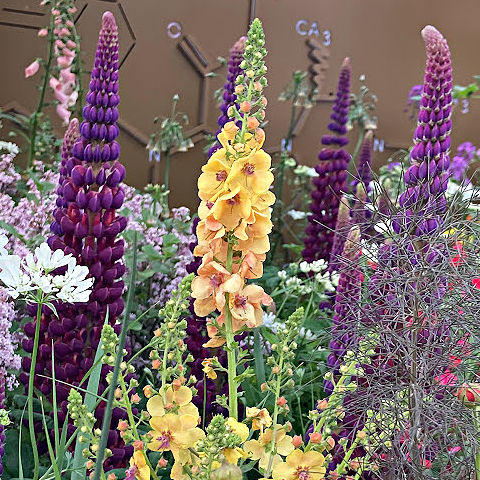
To my mind, there are no rights or wrongs of colour schemes in your garden. It is, after all, your garden, a place for you to express yourself and to experiment. And, it is great to try something new and find that you really like the colour combination.
Here are some suggestions of easy-to-grow contrasting flower colours.
Deep purple and soft yellow
Lupin ‘Masterpiece’
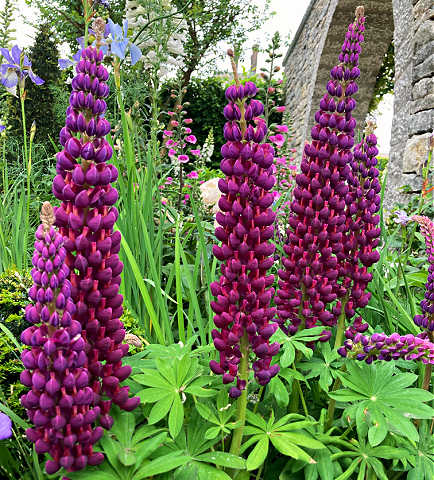
Lupins prefer loam or sandy soils on a sheltered site, but usually still put on a show in conditions that are less than ideal. Hardy across the UK and Ireland, except in the most severe of winters. Deadhead regularly to encourage continued flower production. ‘Masterpiece’ has an intense red-purple with a fleck of orange on a bushy plant up to 75cm height. This photo was taken at RHS Chelsea Flower Show in 2024.
Verbascum ‘Peach Champagne’
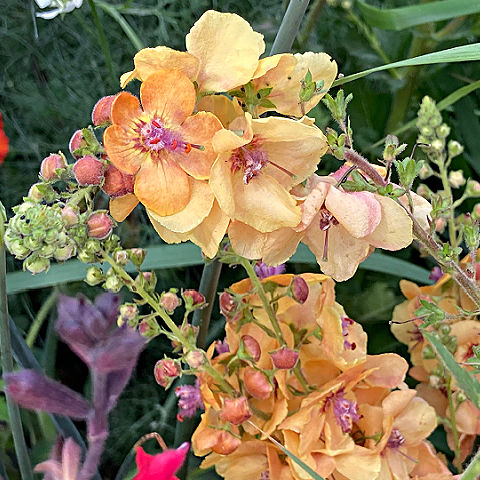
Verbascum likes a well-drained soil that is neutral or alkaline. Grow in full sun in sheltered spot for best results. They will thrive on poor soils, especially a gravelly soil. Try a variety like Verbascum ‘Peach Champagne’. 50cm height and 30cm spread. I’ve had pretty good results in raised beds, on our north-facing hillside, so don’t be put off if you cannot provide perfect growing conditions.
Lime green and pink
Cotinus coggygria Golden Spirit (‘Ancot’) (PBR)
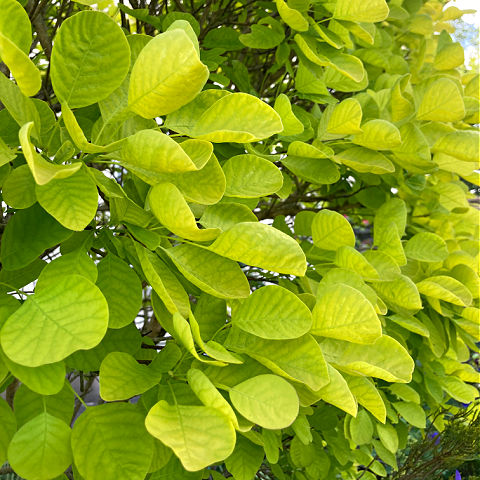
Cotinus are deciduous shrubs that are most often known for their dark purple leaves, but this a lime-yellow variety. It produces a mass of tiny green flowers in July and August. It is fully hardy and grows to 500cm height and spread. Grow in a sunny spot, in moderately fertile soil that is moist, but does not become waterlogged.
Knautia macedonica ‘Melton Pastels’
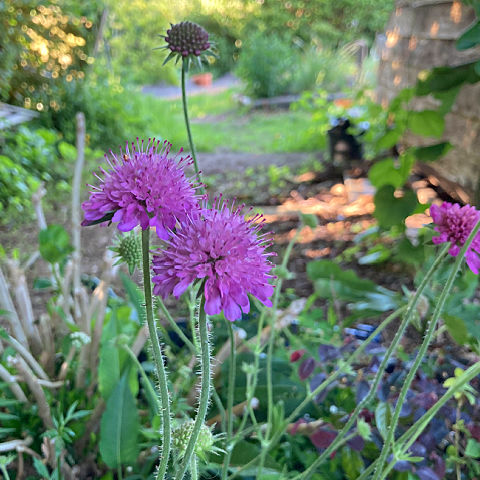
These clump-forming herbaceous perennials (semi-evergreen in mild winters) have dark green leaves that give no indication of the fabulous flower display to come. Deadhead regularly and they continue to produce flowers from May to the late autumn. ‘Melton Pastels’ offer a range of pinks from very pale to deep raspberry in tone. Easy to grow from seed and basal softwood cuttings. Height 90cm and 50cm spread. This is one of the plants that I am asked about most often when people visit my garden.
Orange and blue
For a spring combination of contrasting flower colours, orange tulips growing through forget-me-nots looks wonderful. Try Tulip ‘Orange Balloon’ for a large, well-shaped flower.
Papaver Rhoeas ‘Amazing Grey’
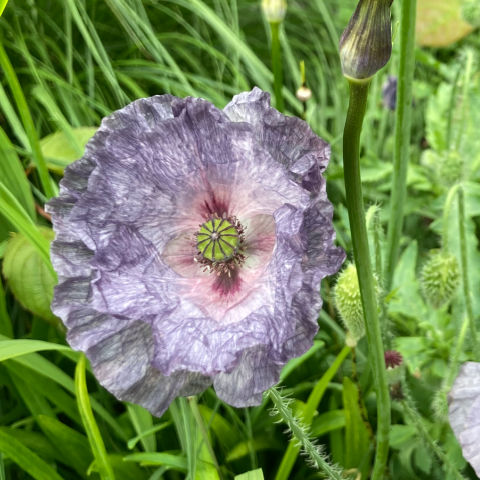
A hardy annual, sow seeds March to June for flowers up to early autumn. Poppies dislike root disturbance, so it’s best to sow where they are to flower and thin seedlings as necessary. Height up to 40cm – 60cm. I think there’s a subtle beauty in these poppies that I spotted in containers outside a hotel in South Wales.
Geum ‘Totally Tangerine’
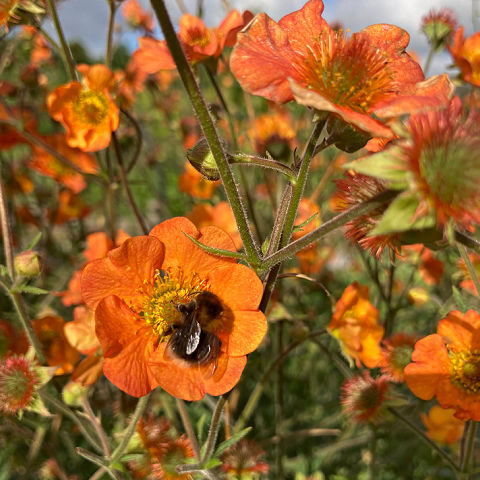
This is a popular Geum and for good reason. The plant in my vegetable garden (grown to attract pollinators) flowers almost year-round with little input from me. Deadhead very regularly for continued flowering, and cut back the flower stems or you end up with a very spiky looking plant. Height 90cm and 50cm spread. It is unfussy about soil or situation, but does need to grow in full sun for best results.
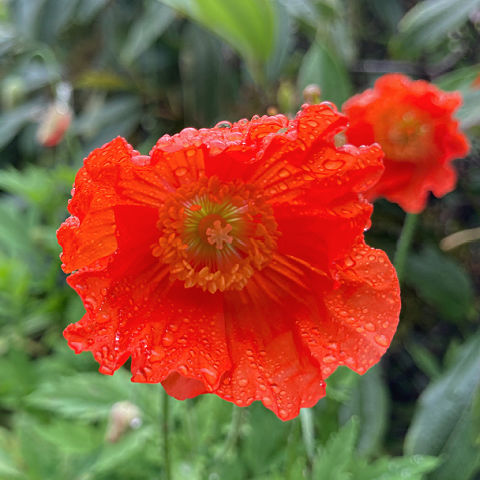
For a vibrant orange, try an orange Welsh poppy.
Red and green
To team with the green of foliage in your garden, choose a bright, fiery or rich red.
Papaver orientale ‘Black Peony’
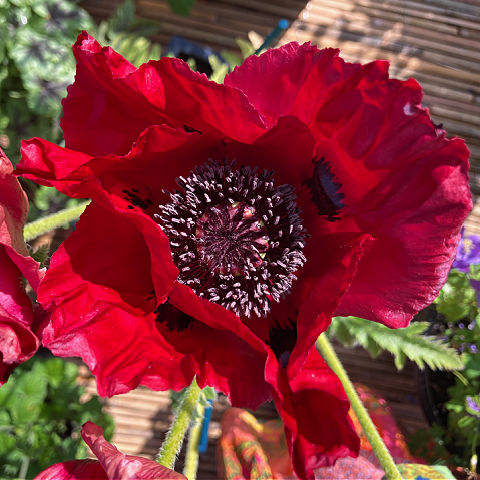
This poppy is an herbaceous perennial with showy, but short-lived flowers. Luckily an established clump will continue to bloom over a period of weeks. It is easy to grow on all soil types. Oriental poppies require full sun and will fail to thrive in very dry or waterlogged soils. Height 90cm. Propagate by dividing clumps every 3-4 years.
Crocosmia ‘Lucifer’
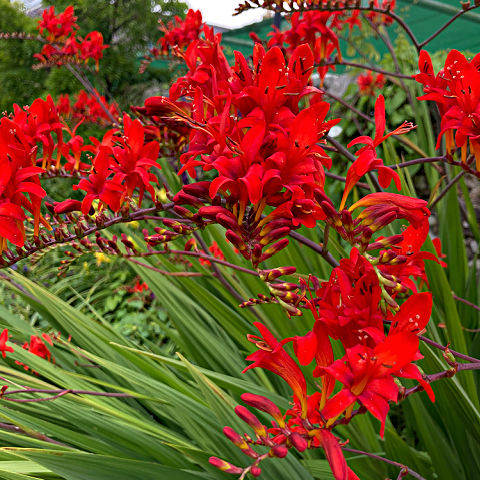
Crocosmia grows from a corm and produces striking flowers from June to September on upright colourful stems, growing to 160cm height. It is relatively unfussy about soil, as long as it is not waterlogged. Crocosmia ‘Lucifer’ is hardy throughout the UK. It has the potential become a bit of a thug if not maintained.
Black and white
Anthriscus sylvestris ‘Ravenswing’
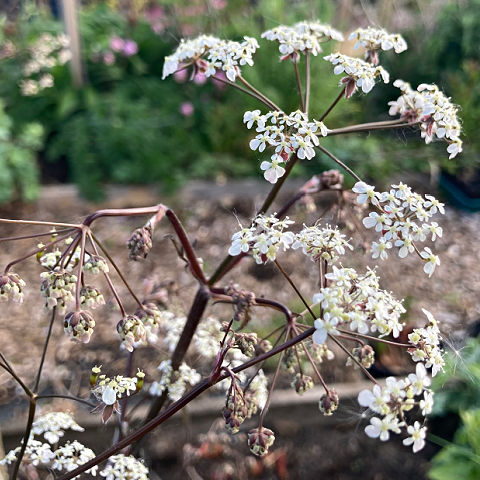
Black cow parsley has very dark purple stems, giving the impression of black colouring with umbels of tiny white flowers, sometimes tinged with pink. These short-lived perennials are relatively unfussy about soil and situation. Grow in full sun or partial shade. They self-seed freely. Height 100cm and 30cm spread. Hardy across the UK and Ireland.
Ophiopogon planiscapus ‘Kokuryū’
Black grass is ideal as a foil for any low growing plant with white flowers. This evergreen perennial forms mounds of arching leaves. Height 20cm and 30cm spread. Grow in all, but chalky soil that is neutral to acid, in moist spot that does not become waterlogged. For best results, grow in full sun or partial shade. It produces small flowers during the summer, followed by inedible glossy, black berries. Hardy in most of the UK and Ireland.

And one last thought this week, don’t be afraid to mix things up and experiment, even to go against your instincts. You may just find a new planting combination that you like in your garden.
I’ve always been convinced that planting pink and yellow together doesn’t work, but I’ve now changed my mind. Because this month at Aberglasney Gardens, I spotted a strong, hot pink Geranium planted with a bright, yellow Hemerocallis. And wow, what an impact they make!
Further information
The article, Contrasting flower colours, was written originally for Amateur Gardening magazine in summer 2025. I have updated some of the specific varieties and images, I have added further plants to the list and I’ve included to help you find the suggested plants.
- Contrasting flower colours - September 26, 2025
- Baby pepper inside pepper | Strange vegetable - September 16, 2025
- Biennials to sow in June and July - September 12, 2025
